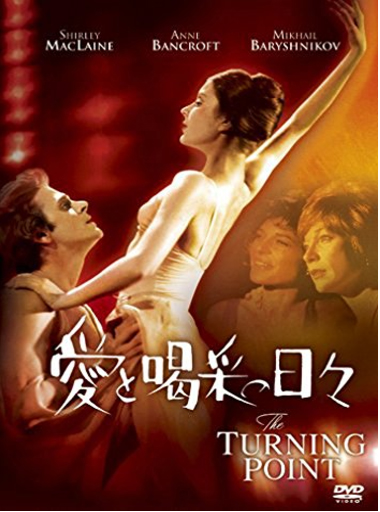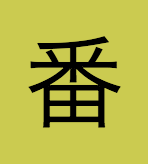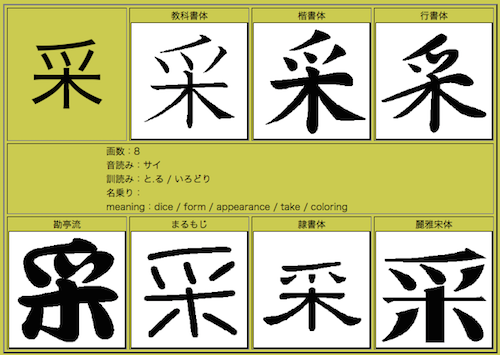165. The "Topped Rice" Radical: 釆
The radical name "topped rice" makes me crave nigiri sushi (nigirizushi in Japanese)—namely, sweet vinegared rice topped with fish. But there's nothing edible here. "Topped rice" is the radical name in English because the seven-stroke 釆 radical looks like 米 (rice) topped with the extra stroke 一. Oh, well!
What Do the Japanese Call the 釆 Radical?
The Japanese call the 釆 radical のごめ, reflecting a similar idea; the hiragana の corresponds to the katakana ノ, which appears to lie atop the 米 in this radical. And ごめ is the voiced version of こめ, the Joyo kun-yomi of 米. Here's an example of a kanji with this radical:
采 (2015: dice; appearance)
When the 釆 radical appears on the left side of a kanji, the Japanese use the name のごめへん, meaning "のごめ radical on the left." Here's an example:
釈 (885: explanation; release; Buddha)
As you can see, the left-side radical is skinny.

Here we find a somewhat messy rendering of 采. It appears in 喝采 (かっさい: acclamation, possibly with applause) at the heart of this movie title:
「愛と喝采の日々」
Love and Acclamation Every Day
愛 (あい: love); 日々 (ひび: every day)
This is the Japanese version of the 1977 American film The Turning Point, which depicted the highs and lows of professional ballet dancing (with quite the cast!). I imagine that the Japanese title alludes to the addictive sweetness of being adored by one audience after another.
A Difference in Shape
The two characters I mentioned, 采 (2015) and 釈 (885), are the only two Joyo kanji featuring the on-duty 釆 radical. But here's a big surprise. Neither kanji features a true example of the "topped rice" radical. It all comes down to a slight difference in shapes.
The lines of the genuine "topped rice" radical touch each other. That's true in four Joyo kanji in which 釆 serves as a mere component:
番 (196: number; ranking; watch; duty)
審 (1443: to examine carefully; clear)
藩 (1721: feudal domain; clan)
翻 (1826: to flutter; overturn; change representation)
It's hard to see these stroke-rich kanji clearly, so here's an enlarged version of 番 (196):

By contrast, in the top half of the kanji 采, the three vertical strokes seldom touch the crowning ノ. You can see that in this display of 采 in various fonts:

We see the same shape in these kanji, in which the radical again serves as a mere component:
菜 (483: vegetable; greens; dish; rape (plant))
採 (682: to pick; gather)
彩 (1290: color; to paint)
The Evolution of 采
The shared shape in these three kanji, as well in 采 (2015) itself, once consisted of a more distinct top (爪) and bottom (木). The 爪 represented "the tips of the fingers and the thumb," and the 木 symbolized a "tree (with or without fruit)," says Kanjigen. Thus, 采 initially meant “to pick manually."
In his newer edition, Henshall similarly interprets 采 as 爪 + 木. He says that although 爪 usually means "claw, talon," it symbolizes "hand" here. As 木 is "tree," the whole 采 character once represented "to pick fruit/nuts from a tree."
As the shape evolved, it came to resemble the top half of 番. Thus, some sources categorize 采 under radical 165 (釆), as I've done. By contrast, Kanjigen (along with other sources) considers the radical in 采 to be 爪 (87: the "claw" radical).
The Violent Origins of 釈
That's not the only evolution to consider here. The 釈 (885) character used to be 釋. Wow, that non-Joyo variant is quite stroke-intensive. I can see why people prefer the 釈 version.
Because 釈 primarily means "explanation; release; Buddha," one might expect a gentle history. However, the etymology is shockingly violent, at least according to the newer edition of Henshall. He presents three etymological explanations. In two of them, the 睪 phonetic represents "to watch criminals," and the 釆 radical means "hand holding seeds." Those two theories lead to dull conclusions.
But in the third interpretation, the 釆 means "claw of a wild beast," and the 睪 represents "corpse of a wild beast." The "net" radical 罒 on top is the "head" of that dead animal! The scholar behind this last theory calls "to explain" an extended sense of this character. Yes, I would say that's quite a big leap from a dead clawed beast!
Photo Credit: Eve Kushner
In the Yanaka section of Tokyo, a temple door features a surprisingly jaunty font! The third kanji from the top is 釋, the older counterpart of 釈.
We find the following terms on the door:
大聖 (だいしょう: lit. “Great Saint,” meaning "Buddha")
釋迦牟尼如来 (しゃかむににょらい: Buddha), in which 迦 and 牟 are non-Joyo
All those kanji function together to convey a simple concept—Buddha!
